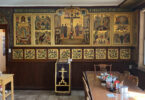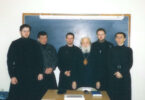Abbess Theodosia (Baranov) passed away on this day in 1988.
Nina (her baptismal name) was born into a practicing Orthodox noble family. She married the officer Alexander Feodorovich Mikhailov, who, during the Civil War, fought in the White Army and was wounded. Alexander Feodorovich’s father was a Major General in the Russian Imperial Army. All six of Alexander’s brothers were killed: two perished during World War II and two at the hands of the Reds, while two others were lost in action.
Both he and Nina ended up in Harbin. They struggled to make ends meet. Alexander worked as a chauffeur. They had to keep chickens in their closet and would fish in the Sungari River (Songhua Jiang) to support themselves and sell whatever they could from their catch.
Harbin was part of the Manchukuo state controlled by the Japanese Imperial Army. Although Japan did not invade the Soviet Union during the critical early years of World War II, the USSR, as an American ally, crossed into Manchuria and occupied Harbin in August of 1945. Thereupon, as in Serbia, Russian emigres began to “disappear” there. The following year, Alexander was arrested, and Nina later learned that he was “shot while attempting to escape.”
Nina then left Harbin for Canada with a family, where she began to work as an au pair. However, as it turns out, Alexander had not been killed. Instead, he had been “returned” to the Soviet Union “to pay his dues for fighting against the nation” during the Civil War. Having done ten years in the GULAG, Alexander Mikhailov located his junior brother, who had survived and settled in the Urals in Chelyabinsk. We know all this from Anna Zamiatina, who, together with her husband, selflessly began to look after Mr. Mikhailov when he was despairing and felt useless. Alexander was an avid reader and once decided to respond to the question in a Soviet newspaper: “Are you happy?” His response that he was happy because he had been born in a Russian Orthodox country and grown up in a Russian Orthodox family was, surprisingly, published and reached Nina in Montreal. At that point, she already was a nun, having taken vows with the name Theodosia. They never met again but kept up a long-distance correspondence.
Mother Theodosia knew Metropolitan Philaret, the third First Hierarch of the ROCOR, while he was still a parish priest in Harbin. It was he who sent her to the Holy Land. Mother Theodosia became the abbess for both Russian convents there: first in Gethsemane and then in the historical, pre-Revolutionary one on the Mount of Olives. There, in 1975, she succeeded Abbess Tamara (Bagration-Mukhranskii), a daughter of Grand Duke Constantine Romanov, who had been in charge of this convent since 1951. In 1984, Abbess Theodosia returned “home” to Gethsemane. She was a hospitable, warm person, and the sisters there still have fond memories of her. Mother Theodosia became a friend of the Russian author and singer-songwriter Bulat Okudzhava. In 1988, the whole Russian church diaspora celebrated the millennium of the Baptism of Rus. It was the last event in recent church history that united all Russian Orthodox across the globe. Abbess Theodosia prepared a lot of food for the guests and pilgrims. Suddenly feeling ill, the Abbess laid down and passed away right then and there. The sisters said she had seen to the arrangements for her memorial dinner….
Sources:
Maria Karelina, “Otmolila muzha u smerti. Istoriia lubvi dvorianki I russkogo ofitsera,” [Her Prayers Protected Her Husband: A Story of the Love of A Noblewoman and Russian Officer]. Argumeny I Fakty. Feb 14, 2014. Photo from the same publication.
Nun Seraphima (Avadd), “Podvizhnitsy Ierusalimskoi Russkoi Gefsimanii,” Russkaia narodnaia linia. July 19, 2023.











